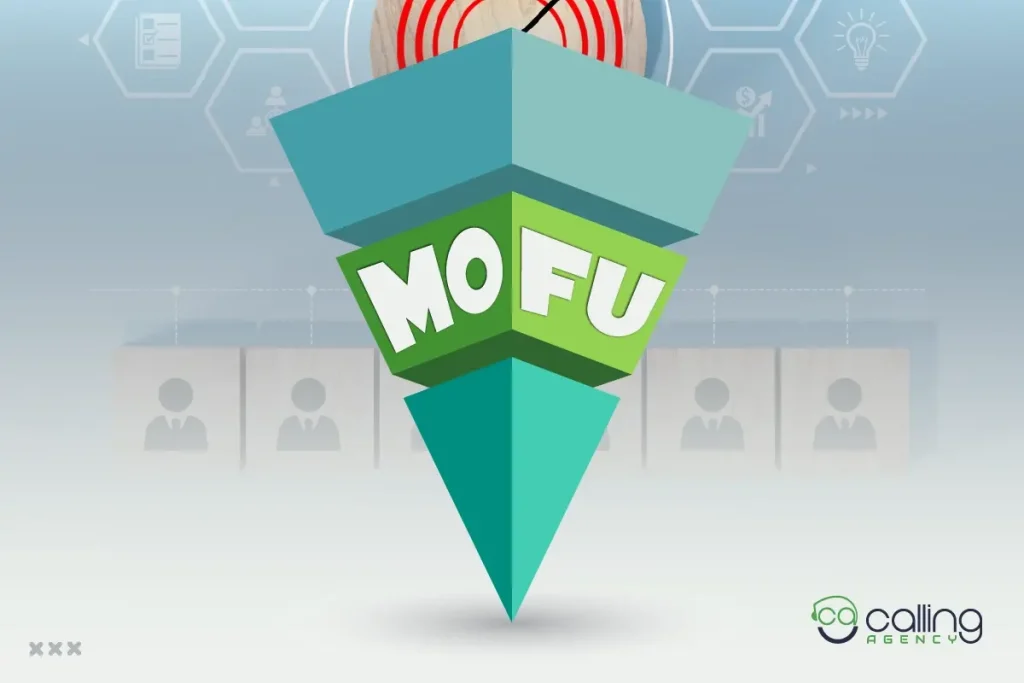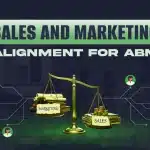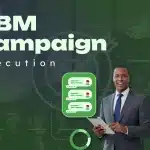Converting potential audiences to convertible customers, the middle of the funnel is a crucial stage.
Here, you have to create and provide different types of content like product comparisons, case studies, webinars and demos, whitepapers and ebooks, and email nurturing to educate potential prospects.
That’s why we are going to give you a complete idea about MOFU. This will include why it matters for lead nurturing and how to produce high-quality MOFU content.
Some of the common types of middle-of-the-content are product comparisons, case studies, webinars & demos, whitepapers and ebooks, email nurturing sequences, etc. So, let’s go into the in-depth discussion.
What Is the Middle of the Funnel (MOFU)?
The middle of the funnel (MOFU) represents the consideration stage in the buyer’s journey. It is the critical gap between TOFU and decision BOFU.
By this time, your audience is already aware that they have a problem and are actively looking for the best solution.
They’re not strangers whom you’re just trying to introduce to your brand for the first time.
These aren’t bland “leads” which could quickly turn cold. Rather, they are real prospects considering their options and comparing solutions before deciding to buy.
MOFU is similar to the relationship stage of marketing.
It’s the place where trust, credibility, and authority are developed through providing knowledge and one-on-one conversations. Leads right now are attempting to address the following:
- Is this solution appropriate for me?
- Is this brand one I can rely on to save the day?
- Why is this service/product better than the others?
What Happens in the MOFU Stage?
The MOFU stage is where lead nurturing really kicks in. Marketing becomes about converting interest into intent.
That is to say, taking advantage of content and personalized messaging to teach, engage, and qualify leads.
In this phase, three things occur:
- Leads transition from curiosity to analysis – They are aware of their pain points and start comparing options on how to solve them.
- You establish brand authority and trust – When you provide helpful and value-driven content, your brand is seen as an advisor rather than a seller.
- Qualification of leads for the next step – looking at engagement patterns, interests, and feedback allows marketing teams to identify which leads are SQL and ready to follow up.
This is why MOFU content must move beyond just the awareness parts.
It must indicate knowledge, offer solutions, and move the lead further down the conversion path, but without being overly promotional.
Typical examples of what would happen at this stage are:
- They are visiting a LIVE product demo to see your solution in action.
- They opt in for a case study to view real-world results.
- They interact with comparison guides or ROI calculators.
Why MOFU Content Matters for Lead Nurturing?
Make sure your mid-funnel content helps potential customers move from wanting to taking action. It allows brands to cultivate relationships, gain trust, and educate prospects for the last stage of conversion.
Even the best TOFU campaigns fail to create real customers without MOFU content that is strong, because hard sales do more than just provoke people’s curiosity.
Let’s figure out what makes this stage so crucial for lead nurturing strategy.
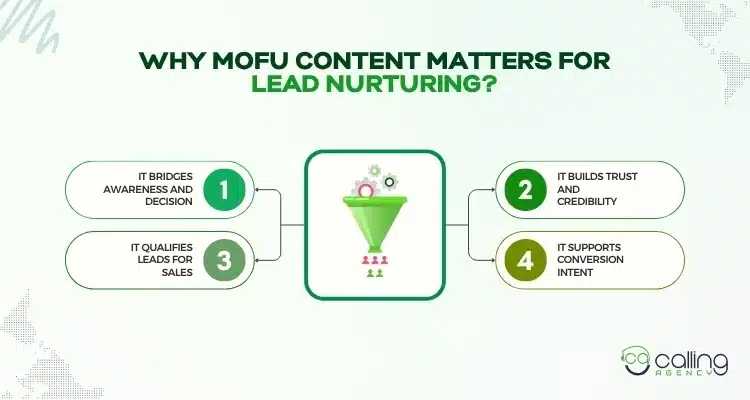
It Bridges Awareness and Decision
Keeping prospects interested after the first time they hear about you is hands down one of the most difficult aspects of marketing.
The MOFU step is the intermediary of awareness (TOFU) and decision (BOFU).
At TOFU, you capture attention. At MOFU, you cultivate understanding. That’s where you’re showing your solution can address their specific challenges and why it’s worth giving more thought to.
If not for MOFU content, leads would be disinterested or start making their way to competitors who are able to provide better instruction and clarity.
So, an effective MOFU plan makes sure that every prospective lead remains engaged and informed, in turn preparing them for the next stage.
It Builds Trust and Credibility
Trust is the key to all conversions. At the MOFU stage, potential customers are also still a little skeptical. They need proof that what you say is true and that your company provides results.
That’s what makes content like case studies, customer testimonials, and in-depth product demos so effective here. These are things that show experience, actual results, and credentials.
Seeing the real data, detailed comparisons, and the honest success stories about your product makes customers start to believe in it, not a sales pitch, but facts.
The aim is to take online behaviour from “this looks interesting” towards “this is trustworthy and reliable”.
It Qualifies Leads for Sales
MOFU content not only nurtures but also filters MQLs. It enables marketing teams to focus on those prospects that are really ready to buy.
For example, downloading a product comparison guide or attending a webinar on pricing is a signal of high buying intent. However, even if you read only general blogs, you may still be in the awareness phase.
You can also segment b2b sales leads and only move the most qualified ones to the sales team when you see how they engage with MOFU content. This increases your conversion rate and decreases the amount of wasted work you do.
In other words, MOFU content helps you focus on the highest intent leads and nurture the rest in time.
It Supports Conversion Intent
Each of the MOFU content should quietly push your reader toward the decision phase. This doesn’t mean hard-selling. It means confidently moving them through learning, reassurance, and clarity.
For example:
- A webinar can finish with an offer to book a one-on-one demo.
- A case study may have a link to try the product for free.
- An email nurture sequence can push a reader to a pricing page or to book a trial call.
The point is to generate momentum without pressure. By the time a lead hits the BOFU stage, they’ve already been warmed up, educated, and led to believe that they should take action.
That’s why well-crafted MOFU content is not just educational, it gets the buyer ready to say “yes.”
What are the Common MOFU Content Types That Convert?
Commonly used and effective middle-of-the-content types are product comparisons, case studies, whitepapers and ebooks, webinars and demos, email nurture sequences, etc.
We often use these formats to connect with potential leads and prospects during the MOFU marketing stage.
Here are detailed examples of each of the content types that you can easily implement in your marketing tactics.
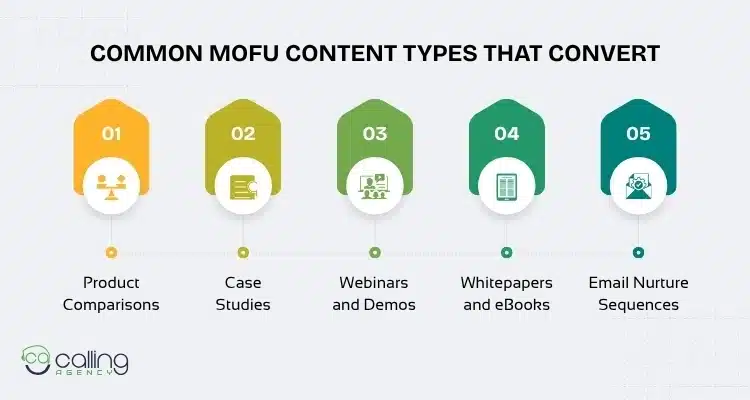
Product Comparisons
Product comparisons are one of the most powerful middle-of-the-funnel content formats to help potential customers understand the core value offerings of the products.
Through the product comparison content, you can easily show the core value of your products by comparing them with competitors’ products.
It shows how your products are different from others and what unique value they provide.
For example, you have SaaS CRM tools. Now you can create different formats of comparison content, like articles, charts with comparison of their core value compared with other CRM tools that are available and often used.
There are some key elements that you should focus on while creating product comparison content.
- Products Features – Shows the key features of the products that ensure unique value.
- Product Description – Include a precise description of the products in the right way.
- Core Benefits – Always focus on showing the major benefits of your products or services.
- Pros and Cons – It’s necessary to explain the pros and cons of the products. So, potential customers easily understand if the products are suitable or not.
When you create the product comparison chart or content, it will come up with some fruitful reasons. These can be helpful for you in multiple ways, like improving the products and customizing the marketing strategy.
- You can easily identify the improvement opportunity and find out user experience gaps.
- Better clarification between you and your targeted prospects and potential customers.
- Through price comparison, you can map the pricing strategy more appropriately based on customers’ demands.
Case Studies
Case studies are some of the most dramatic and convincing MOFU content. They are examples of how our solution impacts a customer in the real world to solve a problem or achieve concrete results.
At this point, prospective buyers are wondering:
- “Is this even something that can help me?”
- “Is anyone else successful with it?”
A well-made case study answers those two questions with evidence and narrative.
Why case studies work:
- They contribute credibility by showing real results (such as higher sales, greater efficiency, or lower costs).
- They show social proof that people trust other customers more than brands.
- They help your readers mentally paint a picture of already winning with your solution in their own business.
Best practices for writing case studies:
- You have to focus on problem solution and a specific result structure.
- Also, you should add measurable metrics in case studies.
- Add customer quotes when possible to make connections to their experiences.
- Make sure that case studies have charts, before and after comparisons for results.
A great case study isn’t just a story, it’s a trust builder and an action driver. You may want to conclude it with an action item like “Get similar results for your team, book a free demo.”
Webinars and Demos
Webinars and live demos are great MOFU content because they unite education with interactivity. They provide an opportunity for prospects to witness your expertise in action and engage one-on-one with your team.
In the funnel’s midsection, prospects are looking to take a closer look at your solution, not a sales pitch, but rather an experience with it that lets them assess fit.
Why webinars and demos convert:
- They build trust through transparency. Live presenting your product demonstrates you have nothing to hide.
- They provide for instant interaction, prospects can ask questions and have their doubts clarified on the spot.
- They help establish your brand as an expert authority, and not just a vendor.
Webinars and demos convert interest into confidence. They’re the bridge between awareness and action, showing leads precisely how your solution is right for them.
Whitepapers and eBooks
Whitepapers and eBooks are cool as cucumbers for those buyers looking to sink their teeth into in-depth, research-based information prior to making a purchase decision.
Because they show authority and thought leadership while educating leads on complex topics, longer-form resources like these are great for those in the MOFU stage.
Unlike short blog posts, these are more in-depth and explanatory materials that go one level deeper into a topic, explaining the “why” and “how” behind your solution.
How whitepapers and eBooks work:
- Provide prospects with guidance on evaluation with deep insights.
- They establish your brand as an authority, especially in B2B sectors.
- It helps in bringing qualified leads for your business. Educate them to understand the value of your products.
Tips for creating high-performing whitepapers and eBooks:
- First, focus on solving the action point. Don’t start adding product-selling information directly.
- Optimize your statements in case examples, expert analysis, and proper data.
- Make them look good if you make it easy to navigate, charts, and graphics.
- Include download CTAs throughout your website and continue the conversation with an email sequence.
These types of content are most effective with lead capture forms. After someone downloads your resource, you can assume they are seriously looking at your solution and have an opportunity to nurture them with a customized follow-up.
Email Nurture Sequences
When it comes to MOFU leads, email nurture sequences are among your best tools for leading them through that stage.
Email sequences are effective for nurturing prospects with a proper one-on-one relationship. Provide them with the requested contents and gradually convert them into potential clients.
When people download a whitepaper, attend a webinar, or watch a demo, an email sequence will help keep the conversation going.
Why nurture emails are so effective:
- It improves the audience engagement.
- Email sequences can be customized based on interest, funnel stage, and behavior.
- Build trustworthiness with stories, learning, and deals.
How to set nurture sequences up:
- Create problem-solving emails that are informative and inspiring for the customers.
- In the email sequences, add testimonials, success stories, and case studies.
- Customize the email content, focusing on a direct answer to the customers’ problems.
- Close the emails with an actionable CTA, booking demos, try the free plan, etc.
How to Produce High-Converting MOFU Content
The overall goal with great MOFU content is guiding qualified leads towards trust and purchase.
Here’s a list of the things that you need to do in order to create wonder MOFU content that nurtures and leads them perfectly down the path towards conversion.
Identify Buyer Pain Points and Objections
To create effective MOFU content, understand what stops your prospects from taking action. By this stage, they know their problems. You should also ask questions like:
- “Will it definitely make a difference to my business?”
- “Is it worth the price?”
- “Why is your product or service different from others?”
When you understand your audience’s pain points and objections, you can create content that addresses those issues directly.
You can easily create content depending on prospects’ objections and pain points. These contents will directly help the prospects to solve their issue.
Also, customers will know the value of your brand and increase trustworthiness among them. This will reassure that your service is more reliable than competitors.
How to find buyer pain points:
- First, communicate with the sales team. From here, you will get an idea about common questions and problems with queries.
- Then check the customers’ feedback and reviews. You can understand their issues and complaints from actual comments.
- The easiest question you can ask your readership is what their biggest challenges are when considering options.
- Look at how they’re positioning their product and what problems they are solving.
Once you’re aware of the obstacles, you can develop MOFU assets such as:
- Comparison pages to show why your solution is unique.
- Real-world case studies from the trenches.
- Knowledge-based videos or articles that address common questions.
Once a combination of context and help has converted someone, they start to view your brand as a mentor rather than an interruptive salesperson.
Align Content With Consideration-Stage Intent
There’s a role for every stage in the funnel. TOFU content is about awareness. BOFU content is about decision-making. And MOFU content is all about qualifying.
For your MOFU strategy to work, you need to make sure all content is aligned with consideration-stage intent in other words, it should help leads compare, evaluate, and validate solutions.
- In-depth guides
- Expert comparisons
- Feature breakdowns
- ROI or cost-benefit analyses
- Customer success stories
Your MOFU content should speak to them right where they are.
Examples of aligned MOFU content:
- A webcast that shows a day in the life with your solution.
- A features comparison blog that shows what makes your product stand out.
- An explanatory ebook or whitepaper detailing your vision of how to solve particular industry problems.
- A sequence of emails that informs leads of benefits, use cases, and results.
It‘s all about clearing the rags and getting it to make sense. Avoid overloading the audience with technical jargon or hard-sell talk. Instead, walk them through logically for recognizing the problem to making an empowered decision.
When your MOFU content aligns with the user intent, it facilitates them in viewing your product as their best fit, before they even have a conversation with a sales rep.
Advantage Data and Social Proof
Data builds trust. Social proof builds confidence. MOFU contents establish trustworthiness among the audience about your products and services.
When it comes time for buyers to compare options, they are not looking only for features, they’re looking for evidence that your solution really works. That’s where data and social validation come through.
Ideas for utilising data and social proof in MOFU content:
- Indicate the measurable results your clients realized.
- Feature genuine quotes and testimonials from happy customers.
- Highlight any awards, certifications, or media mentions that reinforce your authority.
- Provide findings from your own data, like “90% of users saw results in two weeks.”
Example: Don’t say “Our software improves workflow.” Do “Teams using our software removed 40% of manual tasks from the process in 3 months.”
This type of evidence-based storytelling builds credibility with skeptical buyers. It transforms your claims into cold, hard evidence of the innovation and value you offer, which is what people need (when they’re at the MOFU stage) to have confidence to take action forward.
Include Clear CTAs That Guide to BOFU
One of the biggest mistakes we see marketers make is that they produce great MOFU and then forget to deliver what’s next.
Your MOFU content will always guide the reader gently down to the Bottom of the Funnel (BOFU), where they’re ready to make a decision. But the CTA (Call to Action) here should be organic, beneficial, and related.
Examples of effective MOFU CTAs:
- After a case study -“Discover how our solution can benefit your business. Schedule a demo.”
- From a Webinar -“Want to see this in action? Schedule a personalized walkthrough.”
- After an ebook -“Start now with our implementation checklist.”
Every CTA has to agree with the position of buyer readiness, not push them to buy, but move them closer.
Remember, the point of MOFU isn’t selling. It’s moving from interest to intent. A strong, value-driven CTA lets the prospect know what to do next and why it’s important.
Examples of Successful MOFU Content
To help get an idea of what works best, let’s examine a few examples of how brands do a great job with MOFU content to take leads through the nurturing and conversion funnel.
HubSpot’s Webinars
HubSpot hosts educational webinars that tackle marketing and sales subjects. They don’t sell software, they solve audience problems and provide practical solutions. And that creates credibility, but it has people wanting to go check out HubSpot’s tools afterwards.
Salesforce’s Case Studies
Salesforce’s shares tell stories of actual customers and how they managed to grow with the help of their CRM. These case studies provide an overview of challenges, strategies, results, and customer quotes, a wonderful example of merging storytelling with data to establish trust.
Ahrefs’ Comparison and Tutorial Content
Ahrefs publishes blog posts and videos that compare SEO tools and indicate advanced features. Such content pieces assist a user in making an educated decision and position Ahrefs as an authority on SEO.
Canva’s Email Sequences
Canva places trial users into email nurture campaigns where they’re sent targeted emails that feature different templates, success stories, and creative use cases. These onboarding emails then convert free users to paying customers by showing them a concrete value and ease of use.
Final Thoughts
Finally, we are at the end of our discussion about the middle of the funnel marketing strategy. In this article, we have discussed all about MOFU, from why it matters for lead nurturing, types of middle of the funnel content, producing methods of middle of the funnel content, and convenient examples.

